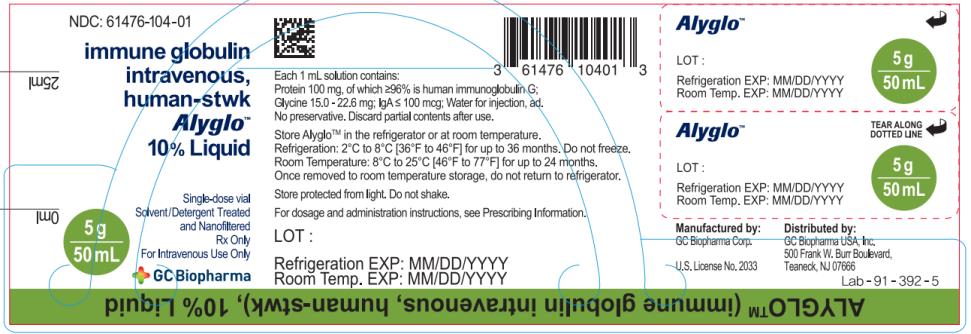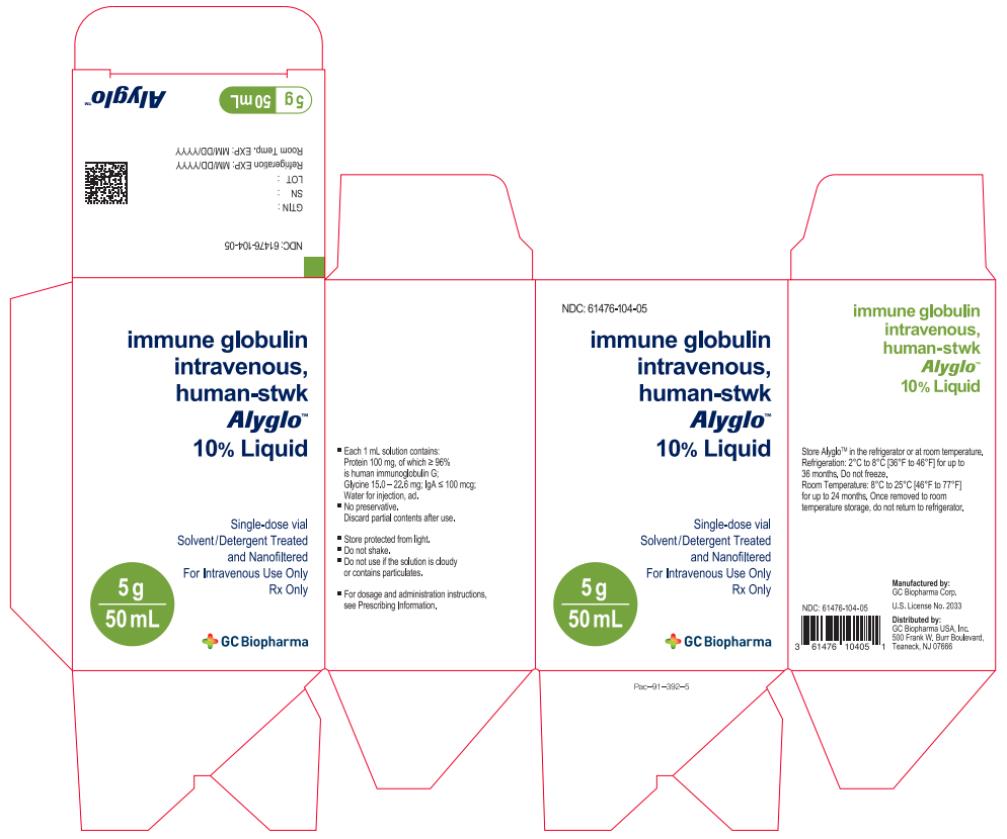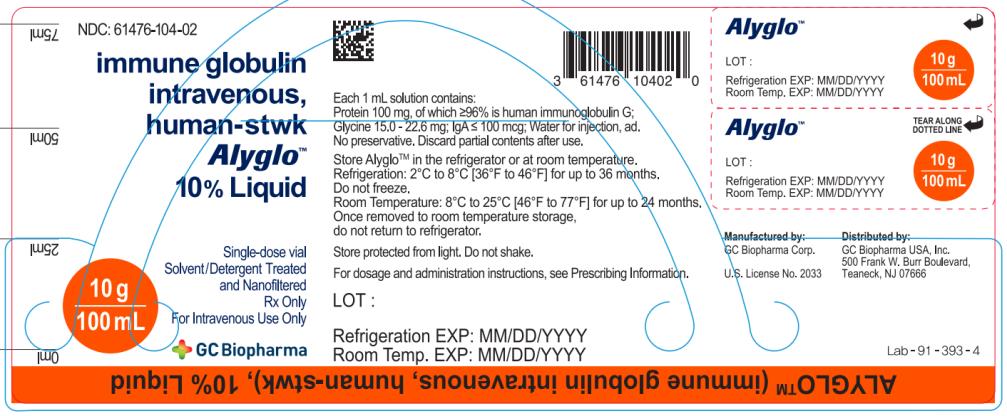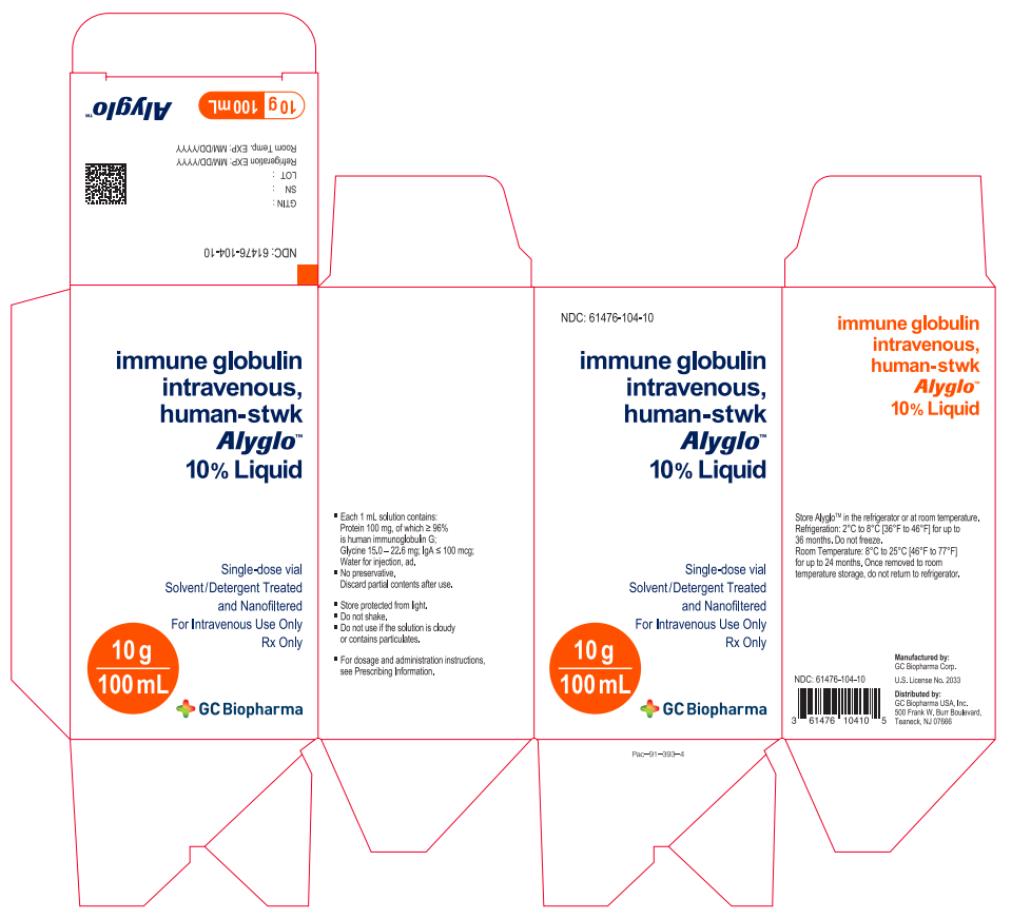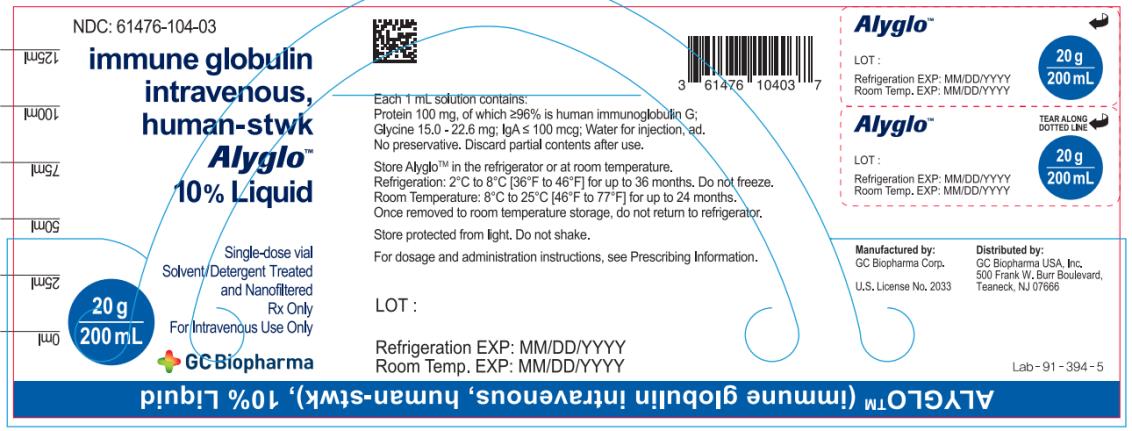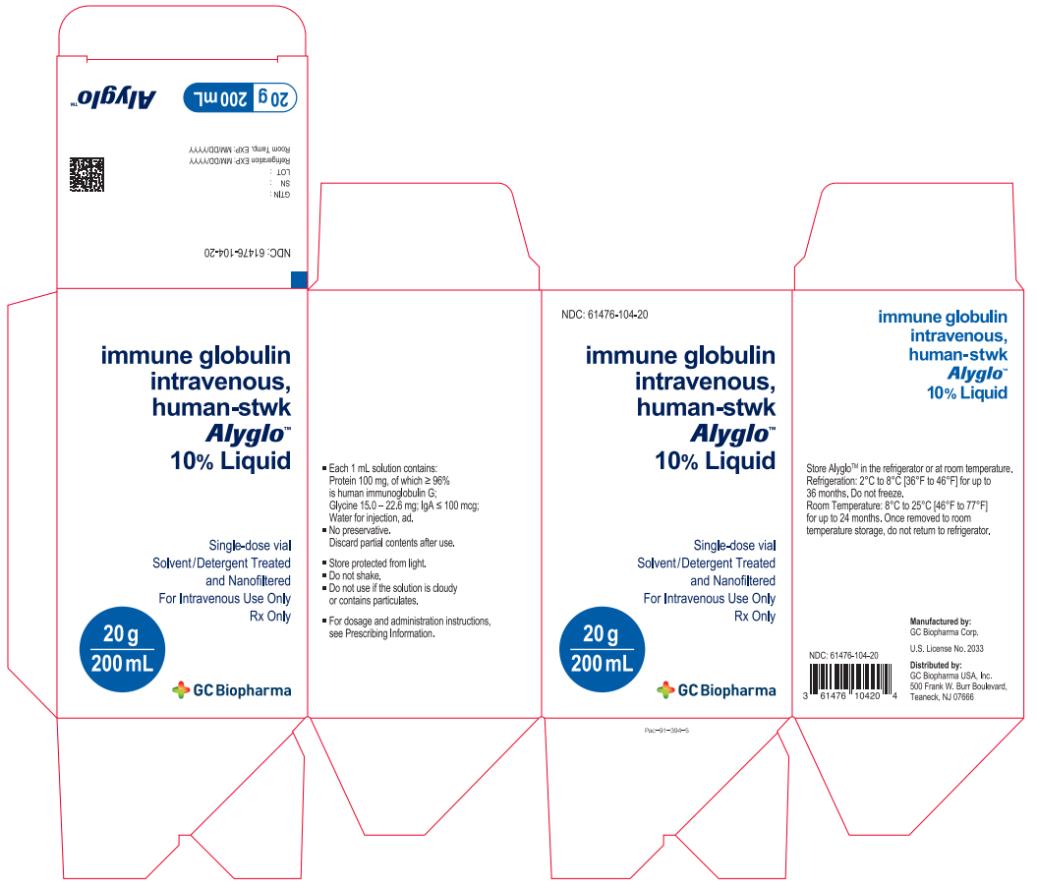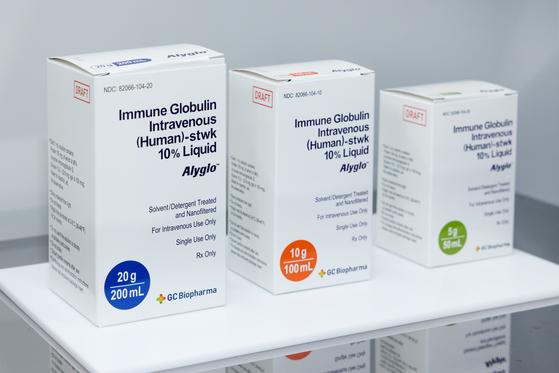Alyglo: Package Insert / Prescribing Info
Package insert / product label
Generic name: human immunoglobulin g
Dosage form: intravenous injection
Drug class: Immune globulins
Medically reviewed by Drugs.com. Last updated on Feb 2, 2024.
On This Page
- Indications and Usage
- Dosage and Administration
- Dosage Forms and Strengths
- Contraindications
- Warnings and Precautions
- Adverse Reactions/Side Effects
- Drug Interactions
- Use In Specific Populations
- Overdosage
- Description
- Clinical Pharmacology
- Nonclinical Toxicology
- Clinical Studies
- References
- How Supplied/Storage and Handling
- Patient Counseling Information
Highlights of Prescribing Information
ALYGLO (immune globulin intravenous, human-stwk), 10% Liquid
Initial U.S. Approval: 2023
WARNING: THROMBOSIS, RENAL DYSFUNCTION AND ACUTE RENAL FAILURE
See full prescribing information for complete boxed warning.
-
Thrombosis may occur with immune globulin intravenous (IGIV) products, including ALYGLO. Risk factors may include: advanced age, prolonged immobilization, hypercoagulable conditions, history of venous or arterial thrombosis, use of estrogens, indwelling vascular catheters, hyperviscosity, and cardiovascular risk factors.
-
Renal dysfunction, acute renal failure, osmotic nephropathy, and death may occur with the administration of IGIV products in predisposed patients.
-
Renal dysfunction and acute renal failure occur more commonly in patients receiving IGIV products containing sucrose. ALYGLO does not contain sucrose.
- For patients at risk of thrombosis, renal dysfunction or renal failure, administer ALYGLO at the minimum dose and infusion rate practicable. Ensure adequate hydration in patients before administration. Monitor for signs and symptoms of thrombosis and assess blood viscosity in patients at risk for hyperviscosity.
Indications and Usage for Alyglo
ALYGLO (immune globulin intravenous, human-stwk) is a 10% immune globulin liquid for intravenous injection, indicated for the treatment of primary humoral immunodeficiency (PI) in adults (1).
Alyglo Dosage and Administration
For intravenous use only.
| Dose | Infusion Number | Initial Infusion Rate | Maintenance Infusion Rate |
| 300 ‒ 800 mg/kg body weight every 21 or 28 days | For the 1st Infusion | 1 mg/kg/min (0.01 mL/kg/min) | Double the infusion rate every 30 minutes (if tolerated) up to 8 mg/kg/min (0.08 mL/kg/min) |
| 300 ‒ 800 mg/kg body weight every 21 or 28 days | From the 2nd Infusion | 2 mg/kg/min (0.02 mL/kg/min) | Double the infusion rate every 15 minutes (if tolerated) up to 8 mg/kg/min (0.08 mL/kg/min) |
Dosage Forms and Strengths
ALYGLO is a liquid solution containing 10% IgG (100 mg/mL) for intravenous infusion (3).
Contraindications
Warnings and Precautions
- IgA-deficient patients with antibodies to IgA are at greater risk of developing severe hypersensitivity and anaphylactic reactions to ALYGLO. Epinephrine should be available immediately to treat any severe acute hypersensitivity reactions (5.1).
- Thrombotic events have occurred in patients receiving IGIV treatments. Monitor patients with known risk factors for thrombotic events; consider baseline assessment of blood viscosity for patients at risk of hyperviscosity (5.2, 5.4).
- Monitor renal function, including blood urea nitrogen and serum creatinine, and urine output in patients at risk of developing acute renal failure (5.3).
- Hyperproteinemia, increased serum viscosity, and hyponatremia or pseudohyponatremia may occur in patients receiving IGIV therapy (5.4).
- Aseptic meningitis syndrome (AMS) may occur, especially with high doses or rapid infusion (5.5).
- Hemolysis that is either intravascular or due to enhanced red blood cell sequestration can develop subsequent to IGIV treatments. Risk factors for hemolysis include high doses and non-O blood group. Closely monitor patients for hemolysis and hemolytic anemia (5.6).
- Monitor patients for pulmonary adverse reactions [transfusion-related acute lung injury (TRALI)] (5.7).
- ALYGLO is made from human plasma and may contain infectious agents, e.g., viruses and, theoretically, the Creutzfeldt-Jakob disease (CJD) agent (5.8).
Adverse Reactions/Side Effects
The most common adverse reactions, observed in ≥ 5% of study subjects, were headache, nausea/vomiting, fatigue, nasal/sinus congestion, rash, arthralgia, diarrhea, muscle pain/aches, infusion site pain/swelling, abdominal pain/discomfort, cough, and dizziness(6).
To report SUSPECTED ADVERSE REACTIONS, contact GC Biopharma USA, Inc. at 1-833-426-6426 or FDA at 1-800-FDA-1088 or http://www.fda.gov/medwatch.
Drug Interactions
Use In Specific Populations
- Geriatric use: In patients over age 65 or in any patient at risk of developing renal insufficiency, do not exceed the recommended dose, and infuse ALYGLO at the minimum infusion rate practicable (8.5).
See 17 for PATIENT COUNSELING INFORMATION.
Revised: 12/2023
Full Prescribing Information
WARNING: THROMBOSIS, RENAL DYSFUNCTION, AND ACUTE RENAL FAILURE
-
Thrombosis may occur with immune globulin (IGIV) products, including ALYGLO. Risk factors may include: advanced age, prolonged immobilization, hypercoagulable conditions, history of venous or arterial thrombosis, use of estrogens, indwelling central vascular catheters, hyperviscosity, and cardiovascular risk factors. Thrombosis may occur in the absence of known risk factors [see Warnings and Precautions (5.2), Patient Counseling Information (17)].
-
Renal dysfunction, acute renal failure, osmotic nephrosis, and death may occur in predisposed patients who receive IGIV products, including ALYGLO. Patients predisposed to renal dysfunction include those with any degree of pre-existing renal insufficiency, diabetes mellitus, age greater than 65, volume depletion, sepsis, paraproteinemia, or patients receiving known nephrotoxic drugs. Renal dysfunction and acute renal failure occur more commonly in patients receiving IGIV products containing sucrose. ALYGLO does not contain sucrose.
- For patients at risk of thrombosis, renal dysfunction or acute renal failure, administer ALYGLO at the minimum dose and infusion rate practicable. Ensure adequate hydration in patients before administration. Monitor for signs and symptoms of thrombosis and assess blood viscosity in patients at risk for hyperviscosity [see Dosage and Administration (2.3), Warnings and Precautions (5.3, 5.4)].
1. Indications and Usage for Alyglo
ALYGLO (immune globulin intravenous, human-stwk) is a 10% immune globulin liquid for intravenous injection, indicated for the treatment of primary humoral immunodeficiency (PI) in adults. This includes, but is not limited to, the humoral immune defect in congenital agammaglobulinemia, common variable immunodeficiency (CVID), X-linked agammaglobulinemia, Wiskott-Aldrich syndrome, and severe combined immunodeficiency (SCID).
2. Alyglo Dosage and Administration
For intravenous use only.
2.1 Dose
| Dose | Infusion Number | Initial Infusion Rate | Maintenance Infusion Rate |
| 300 ‒ 800 mg/kg body weight every 21 or 28 days | For the 1st Infusion | 1 mg/kg/min (0.01 mL/kg/min) | Double the infusion rate every 30 minutes (if tolerated) up to 8 mg/kg/min (0.08 mL/kg/min) |
| 300 ‒ 800 mg/kg body weight every 21 or 28 days | From the 2nd Infusion | 2 mg/kg/min (0.02 mL/kg/min) | Double the infusion rate every 15 minutes (if tolerated) up to 8 mg/kg/min (0.08 mL/kg/min) |
Significant differences in the half-life of IgG among patients with PI may necessitate the dose and frequency of immunoglobulin therapy to vary from patient to patient. Determine the proper dose and frequency by monitoring clinical response.
Measles Exposure
If a patient has been exposed to measles, consult with physician to administer an extra dose of IGIV as soon as possible and within 6 days of exposure. A dose of 400 mg/kg should provide a serum level > 240 mIU/mL of measles antibodies for at least two weeks.
If a patient is at risk of future measles exposure and receives a dose of less than 530 mg/kg every 3 - 4 weeks, then the dose should be increased to at least 530 mg/kg. This should provide a serum level of 240 mIU/mL of measles antibodies for at least 22 days after infusion.
2.2 Preparation and Handling
- ALYGLO (immune globulin intravenous, human-stwk) is a clear or slightly opalescent, colorless or pale yellow solution. Inspect parenteral products visually for particulate matter and discoloration prior to administration, whenever solution and container permit. Do not use ALYGLO if the solution is cloudy or turbid, or if it contains particulate matter.
- Do not freeze, and do not use any ALYGLO that has been frozen.
- Do not shake.
- Do not mix ALYGLO with other IGIV products or other intravenous medications.
- Do not dilute.
- ALYGLO should be at room temperature at the time of administration. Allow refrigerated product to come to room temperature before use.
- Do not use beyond the expiration date on the product label.
- ALYGLO vial is for single use only. Due to the absence of anti-microbial preservatives, promptly administer ALYGLO after piercing the cap. Dispose of partially used or unused product.
- Infuse ALYGLO using a separate infusion line.
- An infusion pump may be used to control the rate of administration.
- ALYGLO may be pooled under aseptic conditions into sterile infusion bags. Infuse within 24 hours after pooling.
2.3 Administration
- Monitor vital signs throughout the infusion. Slow or stop the infusion if adverse reactions occur. If symptoms subside, the infusion may be resumed at a lower rate that is comfortable for the patient.
- Ensure that patients with pre-existing renal insufficiency are not volume-depleted. For patients at increased risk of renal dysfunction or thrombotic events, administer ALYGLO at the minimum infusion rate practicable, and consider discontinuation of administration if renal function deteriorates [see Boxed Warning, Warnings and Precautions (5.2, 5.3)].
- After administration, the infusion line may be flushed with either normal saline or 5% dextrose in water.
3. Dosage Forms and Strengths
ALYGLO (immune globulin intravenous, human-stwk) is a liquid solution containing 10% IgG (100 mg/mL) for intravenous infusion.
4. Contraindications
ALYGLO (immune globulin intravenous, human-stwk) is contraindicated in:
- Patients who have a history of anaphylactic or severe systemic reaction to the administration of human immune globulin.
- IgA-deficient patients with antibodies to IgA and a history of hypersensitivity [see Warnings and Precautions (5.1)].
5. Warnings and Precautions
5.1 Hypersensitivity
Severe hypersensitivity reactions may occur1. In case of hypersensitivity, discontinue ALYGLO infusion immediately and institute appropriate treatment. Have epinephrine available for immediate treatment of severe acute hypersensitivity reactions.
ALYGLO contains trace amounts of IgA (≤ 100 mcg/mL) [see Description (11)]. Patients with known antibodies to IgA may have a greater risk of developing potentially severe hypersensitivity and anaphylactic reactions. ALYGLO is contraindicated in IgA-deficient patients with antibodies against IgA or a history of hypersensitivity reaction [see Contraindications (4)].
5.2 Thrombotic Events
Thrombosis may occur following treatment with ALYGLO2,3,4. Risk factors may include: advanced age, prolonged immobilization, hypercoagulable conditions, history of venous or arterial thrombosis, use of estrogens, indwelling central vascular catheters, hyperviscosity and cardiovascular risk factors. Thrombosis may occur in the absence of known risk factors.
Consider baseline assessment of blood viscosity in patients at risk for hyperviscosity, including patients with cryoglobulins, fasting chylomicronemia/markedly high triacylglycerols (triglycerides), or monoclonal gammopathies. For patients at risk of thrombosis, administer ALYGLO at the minimum dose and infusion rate practicable. Ensure adequate hydration in patients before administration. Monitor for signs and symptoms of thrombosis and assess blood viscosity in patients at risk for hyperviscosity [see Boxed Warning, Dosage and Administration (2), Patient Counseling Information (17)].
5.3 Renal Failure
Renal dysfunction, acute renal failure, osmotic nephropathy, and death5 may occur upon use of ALYGLO. Ensure that patients are not volume-depleted before administering ALYGLO. Monitor renal function and urine output periodically, especially in patients who are at higher risk of renal failure. Assess renal function, including measurement of blood urea nitrogen (BUN) and serum creatinine before the initial infusion of ALYGLO and at appropriate intervals thereafter. If renal function deteriorates, consider discontinuing ALYGLO [see Patient Counseling Information (17)]. In patients who are at risk of developing renal dysfunction, because of pre-existing renal insufficiency or predisposition to acute renal failure (such as diabetes mellitus, hypovolemia, overweight, use of concomitant nephrotoxic medicinal products or age > 65 years), administer ALYGLO at the minimum infusion rate practicable [see Boxed Warning, Dosage and Administration (2)].
5.4 Hyperproteinemia, Increased Serum Viscosity, and Hyponatremia
Hyperproteinemia, increased serum viscosity, and hyponatremia may occur in patients receiving ALYGLO. It is critical to clinically distinguish true hyponatremia from a pseudohyponatremia that is associated with or causally related to hyperproteinemia with concomitant decreased calculated serum osmolality or elevated osmolar gap. Such treatment aimed at decreasing serum free water in patients with pseudohyponatremia may lead to volume depletion, a further increase in serum viscosity, and a possible predisposition to thrombotic events6.
5.5 Aseptic Meningitis Syndrome (AMS)
AMS may occur with ALYGLO. AMS usually begins within several hours to 2 days following ALYGLO treatment. Discontinuation of treatment has resulted in remission of AMS within several days without sequelae7,8,9.
AMS may occur more frequently with high doses (2 g/kg) and/or rapid infusion of ALYGLO. AMS is characterized by the following signs and symptoms: Severe headache, nuchal rigidity, drowsiness, fever, photophobia, painful eye movements, nausea, and vomiting [see Patient Counseling Information (17)]. Cerebrospinal fluid (CSF) studies frequently reveal pleocytosis up to several thousand cells per cubic millimeter, predominantly from the granulocytic series, and elevated protein levels up to several hundred mg/dL, but negative culture results. Conduct a thorough neurological examination on patients exhibiting such signs and symptoms, including CSF studies, to rule out other causes of meningitis.
5.6 Hemolysis
ALYGLO may contain blood group antibodies that can act as hemolysins and induce in vivo coating of red blood cells (RBCs) with immunoglobulin, causing a positive direct antiglobulin test (DAT) (Coombs test) result and hemolysis10,11,12. Delayed hemolytic anemia due to enhanced RBC sequestration, and acute hemolysis, consistent with intravascular hemolysis, have been reported. Cases of severe hemolysis-related renal dysfunction/failure or disseminated intravascular coagulation have occurred following infusion of IGIV.
The following risk factors may be associated with the development of hemolysis following IGIV administration: High doses (e.g., 2 g/kg or more), given either as a single administration or divided over several days, and non-O blood group13. Other individual patient factors, such as an underlying inflammatory state (as may be reflected by, for example, elevated C-reactive protein or erythrocyte sedimentation rate), have been hypothesized to increase the risk of hemolysis following administration of IGIV14, but their role is uncertain.
Closely monitor patients for clinical signs and symptoms of hemolysis, particularly patients with risk factors noted above. Consider appropriate laboratory testing in higher risk patients, including measurement of hemoglobin or hematocrit.
If clinical signs and symptoms of hemolysis or a significant drop in hemoglobin or hematocrit have been observed, perform confirmatory laboratory testing, including direct antiglobulin test. If transfusion is indicated for patients who develop hemolysis with clinically compromising anemia after receiving ALYGLO, perform adequate cross-matching to avoid exacerbating ongoing hemolysis.
5.7 Transfusion-Related Acute Lung Injury (TRALI)
Noncardiogenic pulmonary edema [Transfusion-Related Acute Lung Injury (TRALI)] may occur in patients administered ALYGLO15. TRALI is characterized by severe respiratory distress, pulmonary edema, hypoxemia, normal left ventricular function, and fever. Signs and symptoms typically appear within 1 to 6 hours following treatment. Patients with TRALI may be managed using oxygen therapy with adequate ventilator support.
Monitor patients for pulmonary adverse reactions. If TRALI is suspected, perform appropriate tests for the presence of anti-neutrophil antibodies and anti-human leukocyte antigen (HLA) antibodies in both the product and the patient's serum.
5.8 Transmissible Infectious Agents
Because ALYGLO is made from human blood, it may carry a risk of transmitting infectious agents, e.g., viruses, the variant Creutzfeldt-Jakob disease (vCJD) agent and, theoretically, the Creutzfeldt-Jakob disease (CJD) agent. The risk of infectious agent transmission has been reduced by screening plasma donors and by including virus inactivation/removal steps in the manufacturing process of ALYGLO.
Report all infections thought by a physician possibly transmitted by ALYGLO to GC Biopharma USA, Inc. at 1-833-426-6426. Discuss the risks and benefits of its use with the patient before prescribing or administering this product [see Patient Counseling Information (17)].
5.9 Monitoring Laboratory Tests
- Periodic monitoring of renal function and urine output is particularly important in patients at increased risk of developing acute renal failure. Assess renal function, including measurement of blood urea nitrogen (BUN) and serum creatinine before the initial infusion of ALYGLO and at appropriate intervals thereafter.
- Because of the potential for increased risk of thrombosis with ALYGLO, consider baseline assessment of blood viscosity in patients at risk for hyperviscosity, including those with cryoglobulins, fasting chylomicronemia/markedly high triacylglycerols (triglycerides), or monoclonal gammopathies.
- If signs and/or symptoms of hemolysis are present after an infusion of ALYGLO, perform appropriate laboratory testing for confirmation. Measure hemoglobin and/ or hematocrit at baseline and approximately 36 to 96 hours post-infusion in patients at higher risk of hemolysis.
- If TRALI is suspected, perform appropriate tests for the presence of anti-neutrophil antibodies in both the product and patient's serum.
5.10 Interference with Laboratory Tests
After infusion of immunoglobulin, the transitory rise of the various passively transferred antibodies in the patient's blood may yield positive serological testing results, with the potential for misleading interpretation. Passive transmission of antibodies to erythrocyte antigens (e.g., A, B, and D) may cause a positive direct or indirect antiglobulin (Coombs) test.
6. Adverse Reactions/Side Effects
The most common adverse reactions, observed in ≥ 5% of study subjects, were headache, nausea/vomiting, fatigue, nasal/sinus congestion, rash, arthralgia, diarrhea, muscle pain/aches, infusion site pain/swelling, abdominal pain/discomfort, cough, and dizziness.
6.1 Clinical Trials Experience
Because clinical trials are conducted under widely varying conditions, adverse reaction rates observed in the clinical trials of a drug cannot be directly compared to rates in the clinical trials of another drug and may not reflect the rates observed in practice.
In an open-label, single-arm, multicenter, non-randomized clinical trial, 33 subjects with primary humoral immunodeficiency received doses of ALYGLO (immune globulin intravenous, human-stwk) ranging from 319 mg/kg to 817 mg/kg every 21 days or 28 days for up to 12 months.
Twenty-eight subjects (85%) experienced a total of 145 temporally associated adverse reactions (adverse events that occurred during or within 72 hours after the end of an infusion) during the study. The temporally associated ARs were headache (13 subjects, 39%), nausea/vomiting (11 subjects, 33%), fatigue (6 subjects, 18%), nasal/sinus congestion (5 subjects, 15%), rash (4 subjects, 12%), arthralgia, diarrhea (3 subjects, 9% each), muscle pain/aches, Infusion site pain/swelling, abdominal pain/discomfort, cough, dizziness (2 subjects, 6% each). These are presented in Table 2.
There were no deaths and no adverse reactions leading to withdrawal from the study.
| Adverse Reactions (ARs) | No. of Subjects Reporting ARs
(Percentage of Subjects) [N1=33] | No. of Infusions with ARs
(Percentage of Infusions) [N2=427] |
| Headache | 13 (39) | 32 (7.5) |
| Nausea/vomiting | 11 (33) | 20 (4.7) |
| Fatigue | 6 (18) | 18 (4.2) |
| Nasal/sinus congestion | 5 (15) | 5 (1.2) |
| Rash | 4 (12) | 4 (0.9) |
| Arthralgia | 3 (9) | 4 (0.9) |
| Diarrhea | 3 (9) | 3 (0.7) |
| Muscle pain/aches | 2 (6) | 7 (1.6) |
| Infusion site pain/swelling | 2 (6) | 6 (1.4) |
| Abdominal pain/discomfort | 2 (6) | 3 (0.7) |
| Cough | 2 (6) | 2 (0.5) |
| Dizziness | 2 (6) | 2 (0.5) |
* Adverse events that occurred during or within 72 hours after the end of an infusion
1 Total number of subjects
2 Total number of infusions
6.2 Postmarketing Experience
Because postmarketing reporting of adverse reactions is voluntary and from a population of uncertain size, it is not always possible to reliably estimate the frequency of these reactions or establish a causal relationship to product exposure. The following adverse reactions have been identified and reported during the post-approval use of marketed IGIV products:
| Blood and lymphatic system disorders
Leucopenia, hemolysis, pancytopenia |
| Immune system disorders
Hypersensitivity (e.g., anaphylaxis), anaphylactic shock, anaphylactic reaction, anaphylactoid reaction, allergic reaction, angioedema, face edema |
| Metabolic and nutritional disorders
Fluid overload, (pseudo) hyponatremia |
| Psychiatric disorders
Agitation, confusion, anxiety, nervousness |
| Nervous system disorders
Coma, loss of consciousness, seizures, (acute) encephalopathy, cerebrovascular accident, stroke, aseptic meningitis, migraine, speech disorder, paresthesia, hypoesthesia, photophobia, tremor |
| Cardiac disorders
Myocardial infarction, cardiac arrest, angina pectoris, tachycardia, bradycardia, palpitations, cyanosis |
| Vascular disorders
Hypotension, (deep vein) thrombosis, peripheral circulatory failure/collapse, hypertension, phlebitis, pallor |
| Respiratory, thoracic and mediastinal disorders
Apnea, Acute Respiratory Distress Syndrome (ARDS), TRALI, respiratory failure, pulmonary embolism, pulmonary edema, bronchospasm, dyspnea, hypoxia, wheezing, cough |
| Gastrointestinal disorders
Diarrhea, hepatic dysfunction, abdominal discomfort |
| Skin and subcutaneous tissue disorders
Eczema, urticaria, rash (erythematous), dermatitis, pruritus, alopecia, Stevens-Johnson syndrome, epidermolysis, skin exfoliation, erythema (multiform), dermatitis (e.g., bullous dermatitis) |
| Musculoskeletal and connective tissue disorders
Back pain, arthralgia, myalgia, musculoskeletal pain, muscle stiffness, pain in extremity, neck pain, muscle spasm |
| Renal and urinary disorders
Acute renal failure, osmotic nephropathy, renal pain |
| General disorders and administration site conditions
Injection-site reaction, chills, chest pain or discomfort, hot flush, flushing, flu-like illness, feeling cold or hot, edema, hyperhidrosis, malaise, asthenia, lethargy, burning sensation |
| Investigations
Hepatic enzymes increased, oxygen saturation decreased, falsely elevated erythrocyte sedimentation rate, positive direct antiglobulin (Coombs) test |
7. Drug Interactions
Clinical studies have not evaluated mixture of ALYGLO (immune globulin intravenous, human-stwk) with other drugs and intravenous solutions. It is recommended that ALYGLO is administered separately from other drugs or medications which the patient may be receiving. Do not mix the product.
Transitory rise of the various passively transferred antibodies in the patient's blood after infusion of immunoglobulin may yield positive serological testing results, with the potential for misleading interpretation. Passive transmission of antibodies to erythrocyte antigens (e.g., A, B, and D) may cause a positive direct or indirect antiglobulin (Coombs) test.
The passive transfer of antibodies with IGIV administration may interfere with the response to live virus vaccines such as measles, mumps, rubella, and varicella. Immunizing physicians should be informed of recent IGIV therapy so that appropriate measures may be taken. [See Patient Counseling Information (17)]
8. Use In Specific Populations
8.1 Pregnancy
Risk Summary
No human data are available to indicate the presence or absence of drug-associated risk. Animal reproduction studies have not been conducted with ALYGLO (immune globulin intravenous, human-stwk). It is not known whether ALYGLO can cause fetal harm when administered to a pregnant woman or can affect reproduction capacity. Immune globulins cross the placenta from maternal circulation increasingly after 30 weeks of gestation. In the U.S. general population, the estimated background risk of major birth defects and miscarriage in clinically recognized pregnancies is 2 – 4% and 15 – 20%, respectively16,17. ALYGLO should be given to pregnant women only if clearly needed.
8.2 Lactation
Risk Summary
No human data are available to indicate the presence or absence of drug-associated risk during lactation. The developmental and health benefits of breastfeeding should be considered along with the mother's clinical need for ALYGLO and any potential adverse effects on the breastfed infant from ALYGLO or from the underlying maternal condition.
8.4 Pediatric Use
Safety and effectiveness in pediatric patients < 17 years has not been established.
8.5 Geriatric Use
Clinical studies of ALYGLO did not include sufficient numbers of subjects aged 65 and over to determine whether they respond differently from younger subjects. Other reported clinical experience has not identified differences in responses between the elderly and younger patients. In general, dose selection for an elderly patient should be cautious, usually starting at the low end of the dosing range, reflecting the greater frequency of decreased hepatic, renal, or cardiac function, and of concomitant disease or other drug therapy.
10. Overdosage
Overdosage may lead to fluid overload and hyperviscosity. Patients at risk of complications of fluid overload and hyperviscosity include elderly patients and those with cardiac or renal impairment.
11. Alyglo Description
ALYGLO (immune globulin intravenous, human-stwk) is a ready-to-use, sterile, liquid preparation of highly purified and concentrated human immunoglobulin G (IgG) antibodies. The product is a clear or slightly opalescent liquid, which is colorless or pale yellow. The distribution of the IgG subclasses is similar to that of normal human plasma. The active ingredient is human immunoglobulin G purified from human Source Plasma and processed using a modified Cohn-Oncley fractionation process, as well as anion and cation exchange chromatography.
ALYGLO contains 100 mg/mL protein, of which not less than ≥ 96% is human IgG obtained from human Source Plasma. It is formulated with glycine targeted at 18.8 mg/mL (15.0 – 22.6 mg/mL) as a stabilizer and water for injection as a solvent with pH in the range of 4.5 – 5.5. ALYGLO contains ≤ 100 mcg/mL of IgA.
All plasma units used in the manufacture of ALYGLO have been tested and approved for manufacture using FDA-licensed serological assays for human hepatitis B surface antigen (HBsAg) and antibodies to human hepatitis C virus (anti-HCV) and human immunodeficiency virus types 1 and 2 (anti-HIV-1/2) as well as FDA-licensed Nucleic Acid Testing (NAT) for HIV-1, HAV, HBV, and HCV and found to be non-reactive (negative). In addition, the plasma has been tested for human parvovirus B19 by NAT. Only plasma that passed virus screening is used for production, and the limit for human parvovirus B19 in the manufacturing plasma pool is set not to exceed 10,000 IU/mL.
The manufacturing process for ALYGLO includes three steps to reduce the risk of virus transmission. The steps are “Fractionation I+III, solvent/detergent (S/D) treatment, and Nanofiltration.”
The steps of Fractionation I+III and Nanofiltration (20 nm) remove both enveloped and non-enveloped viruses, and the S/D treatment step inactivates enveloped viruses. The results of virus validation studies for ALYGLO are shown in Table 3, expressed as log10 reduction factor (LRF).
| Manufacturing Step | LRF for HIV-11 | LRF for PRV1 | LRF for BVDV1 | LRF for EMCV2 | LRF for PPV2 |
| Fractionation I+III | 4.27 | 3.53 | 3.00 | 2.95 | 4.28 |
| S/D treatment | ≥ 5.51 | ≥ 4.43 | ≥ 4.63 | NT | NT |
| Nanofiltration | ≥ 4.77 | ≥ 4.45 | ≥ 5.67 | ≥ 5.20 | 3.65 |
| Total LRF | ≥ 14.55 | ≥ 12.41 | ≥ 13.30 | ≥ 8.15 | 7.93 |
NT: Not Tested
1 Enveloped viruses
2 Non-enveloped viruses
HIV-1: Human Immunodeficiency virus type 1, a model for HIV-1 and HIV-2, PRV: Pseudorabies virus, a model for large enveloped DNA viruses (e.g., herpes virus); BVDV: Bovine viral diarrhea virus a model for e.g., Hepatitis C virus (HCV) and West Nile virus (WNV); EMCV: Encephalomyocarditis virus, a model for Hepatitis A virus (HAV); PPV: Porcine parvovirus, a model for Human Parvovirus B19
12. Alyglo - Clinical Pharmacology
12.1 Mechanism of Action
ALYGLO (immune globulin intravenous, human-stwk) supplies a broad spectrum of neutralizing IgG antibodies to bacterial and viral pathogens, and their toxins. The mechanism of action has not been fully elucidated in PI.
12.2 Pharmacodynamics
ALYGLO contains mainly IgG with a broad spectrum of antibodies against various infectious agents reflecting the IgG activity found in the donor population. ALYGLO which is prepared from pooled material, has an IgG subclass distribution similar to that of native human plasma. An adequate dose of IGIV can restore abnormally low IgG level to the normal range. Standard pharmacodynamics studies were not performed.
12.3 Pharmacokinetics
Serum concentrations of total IgG were measured in 22 subjects (22 adults aged ≥ 17 to 70 years) following the 5th infusion of ALYGLO. The administered dose of ALYGLO during the PK assessment ranged from 313 mg/kg to 821 mg/kg. Blood samples for PK analyses were collected until Day 22 (±1 day) or Day 29 (±2 days) for subjects treated according to the 21 days and 28 days schedule, respectively.
Table 4 summarizes the PK parameters of ALYGLO based on serum concentration of total IgG.
| Parameter (unit) | Statistics | 21 Days Schedule,
Baseline Unadjusted (N=7) | 21 Days Schedule,
Baseline Adjusted (N=7) | 28 Days Schedule,
Baseline Unadjusted (N=15) | 28 Days Schedule,
Baseline Adjusted (N=15) |
| Cmax (mg/mL) | Mean (SD) | 24.1 (4) | 14.4 (3) | 21.2 (4) | 13.5 (4) |
| AUC0-tau (day×mg/mL) | Mean (SD) | 270.9 (56) | 79.3 (32) | 310.2 (61) | 96.6 (62) |
| T1/2 (day) | Mean (SD) | 20.0 (6) | 7.1 (5) | 29.6 (11) | 6.0 (3) |
| Tmax (day) | Mean (SD) | 0.4 (1) | 0.4 (1) | 0.2 (0) | 0.2 (0) |
| CL (mL/day/kg) | Mean (SD) | 2.5 (1) | 9.2 (3) | 1.7 (0) | 8.1 (8) |
| Vss (mL/kg) | Mean (SD) | 63.0 (1) | 49.9 (13) | 48.2 (4) | 50.9 (20) |
AUC0-tau=area under the (time concentration) curve within a dosing interval; CL=clearance based on AUC0-tau; Cmax=maximum serum concentration; SD=standard deviation; Tmax=time to maximum serum concentration; T1/2=elimination half-life; Vss=(apparent) volume of distribution at steady state based on AUC0-tau
13. Nonclinical Toxicology
13.1 Carcinogenesis, Mutagenesis, Impairment of Fertility
No animal studies were conducted on carcinogenesis, mutagenesis, or impairment of fertility with ALYGLO (immune globulin intravenous, human-stwk).
13.2 Animal Toxicology and/or Pharmacology
A single-dose toxicity study was performed in rats at doses up to 3000 mg/kg body weight. No toxicologically significant changes attributable to the test article were observed at any dose.
In safety pharmacology studies, there were no test article related adverse effects on respiratory, cardiovascular or central nervous systems of the treated mice and rats.
14. Clinical Studies
A prospective, open-label, single-arm, multi-center study was conducted in North America (the United States and Canada) to determine efficacy, safety and PK of ALYGLO (immune globulin intravenous, human-stwk) in adults and pediatric subjects with PI. Prior to enrollment, all subjects were receiving stable doses between 300 and 900 mg/kg of IGIV replacement therapy. Subjects received ALYGLO infusion administered every 21 or 28 days (both the dose and schedule depending on their prior therapy) for 12 months.
Thirty-three adults aged 17 to 70 years were enrolled and received doses ranging from 319 to 817 mg/kg. The age range was between 17 and 70 years, with a mean (SD) of 49.6 (16.41) years. Eighteen (54.5%) subjects were female and 15 (45.5%) subjects were male; 32 (97.0%) were White and 1 (3.0%) was other.
The primary efficacy analysis was annualized rate of acute serious bacterial infections (SBIs), defined as bacterial pneumonia, bacteremia/sepsis, bacterial meningitis, visceral abscess, and osteomyelitis/septic arthritis per subject per year. Secondary analyses were annual rate or days of other infections, antibiotic use, days out of work/school/day care or unable to perform normal activities due to infection, and days of hospitalization due to infection.
During the 12-month study period, the acute SBI rate was 0.03 (with an upper one-sided 99% confidence limit: 0.31), which met the predefined success rate of less than one acute SBI per subject per year (ITT Population). One adult subject experienced an acute SBI (one episode of bacterial pneumonia).
Table 5 summarizes the efficacy results for all 33 subjects.
| Category | Result |
| Subject | 33 subjects with 30 subject years on study |
| Annual rate of confirmed acute SBIs | 0.03 acute SBIs/person-year |
| Annual rate of other infections | 2.4 infections/person-year |
| Number of subjects with use of therapeutic antibiotics | 19 subjects (58%) |
| Number of days of therapeutic antibiotics | 14 (5, 63) days* |
| Number of subjects missed at least one day from work/school or days unable to perform normal daily activities due to infection | 14 subjects (42%) |
| Number of days off work/school or days unable to perform normal daily activities due to infection | 6 (1, 80) days* |
| Number of subjects with at least one day of unscheduled physician visits | 19 subjects (58%) |
| Number of subjects with hospitalizations due to infection | 2 subjects (6%) |
| Total days of hospitalization due to infection | 5 days (One subject for 2 days and one subject for 3 days) |
| Annual rate of hospitalizations due to infection | 0.2 days/person-year |
* Number of days is presented as median (min, max)
15. References
- Duhem C, Dicato MA, Ries F. Side-effects of intravenous immune globulins. Clin Exp Immunol 1994: 97 Suppl 1:79-83.
- Dalakas MC. High-dose intravenous immunoglobulin and serum viscosity: risk of precipitating thromboembolic events. Neurology 1994; 44:223- 226.
- Woodruff RK, Grigg AP, Firkin FC, Smith IL. Fatal thrombotic events during treatment of autoimmune thrombocytopenia with intravenous immunoglobulin in elderly patients. Lancet 1986; 2:217-218.
- Wolberg AS, Kon RH, Monroe DM, Hoffman M. Coagulation factor XI is a contaminant in intravenous immunoglobulin preparations. Am J Hematol 2000; 65:30-34.
- Cayco AV, Perazella MA, and Hayslett JP. Renal insufficiency after intravenous immune globulin therapy: a report of two cases and an analysis of the literature. J Am Soc Nephrol 1997; 8:1788-1794.
- Steinberger BA, Ford SM, Coleman TA. Intravenous immunoglobulin therapy results in post-infusional hyperproteinemia, increased serum viscosity, and pseudohyponatremia. Am J Hematol 2003; 73:97-100.
- Casteels-Van Daele M, et al. Intravenous immune globulin and acute aseptic meningitis [letter]. N Engl J Med 1990; 323:614-615.
- Kato E, et al. Administration of immune globulin associated with aseptic meningitis [letter]. Jama 1988; 259:3269-3271.
- Scribner CL, et al. Aseptic meningitis and intravenous immunoglobulin therapy [editorial, comment]. Ann Intern Med 1994; 121:305-306.
- Copelan EA, Stohm PL, Kennedy MS, Tutschka PJ. Hemolysis following intravenous immune globulin therapy. Transfusion 1986; 26:410-412.
- Thomas MJ, Misbah SA, Chapel HM, Jones M, Elrington G, Newsom-Davis J. Hemolysis after high-dose intravenous Ig. Blood 1993; 15:3789.
- Wilson JR, Bhoopalam N, Fisher M. Hemolytic anemia associated with intravenous immunoglobulin. Muscle & Nerve 1997; 20:1142-1145.
- Kahwaji J, Barker E, Pepkowitz S, et al. Acute Hemolysis After High-Dose Intravenous Immunoglobulin Therapy in Highly HLA Sensitized Patients. Clin J Am Soc Nephrol 2009;4:1993-1997.
- Daw Z, Padmore R, Neurath D, et al. Hemolytic transfusion reactions after administration of intravenous immune (gamma) globulin: A case series analysis. Transfusion 2008;48:1598-1601.
- Rizk A, Gorson KC, Kenney L, Weinstein R. Transfusion-related acute lung injury after the infusion of IVIG. Transfusion 2001; 41:264-268.
- Hammarström L, Smith CIE. Placental transfer of intravenous immunoglobulin. Lancet 1986;1:681.
- Sidiropoulos D, Herman U Jr, Morell A, von Muralt G, Barandun S. Transplacental passage of intravenous immunoglobulin in the last trimester of pregnancy. J Pediatr 1986;109:505-508.
16. How is Alyglo supplied
ALYGLO (immune globulin intravenous, human-stwk) is supplied in single-dose, tamper-evident vial containing the labeled amount of functionally active IgG. The components used in the packaging for ALYGLO are not made with natural rubber latex.
The following presentations of ALYGLO are available.
| Grams and Fill Size | Vial NDC Number | Carton NDC Number |
| 5 g in 50 mL | 61476 -104-01 | 61476 -104-05 |
| 10 g in 100 mL | 61476 -104-02 | 61476 -104-10 |
| 20 g in 200 mL | 61476 -104-03 | 61476 -104-20 |
- Keep ALYGLO in its original carton to protect it from light.
- Store ALYGLO in the refrigerator or at room temperature.
- Refrigeration: 2°C to 8°C [36°F to 46°F] for up to 36 months. Do not freeze.
- Room Temperature: 8°C to 25°C [46°F to 77°F] for up to 24 months. Do not return to refrigeration after ALYGLO has been stored at room temperature.
- Expiration dates for both conditions are printed on the outer carton and vial label. Do not use after the expiration date.
- ALYGLO contains no preservatives. The ALYGLO bottle is for single use only. Use promptly any bottle that has been entered or opened and discard partially used bottles.
- Dispose of any unused product or waste material in accordance with local requirements.
17. Patient Counseling Information
Inform patients to immediately report the following signs and symptoms to their healthcare professional:
- Thrombosis which includes pain and/or swelling of an arm or legs/feet with warmth over the affected area, discoloration of an arm or leg, unexplained shortness of breath, acute chest pain or discomfort that worsens on deep breathing, unexplained rapid pulse, numbness or weakness on one side of the body [see Warning and Precaution (5.2)].
- Acute renal dysfunction and acute renal failure which includes decreased urine output, sudden weight gain, fluid retention/edema, and/or shortness of breath. Such symptoms may suggest kidney damage [see Boxed Warning, Warnings and Precautions (5.3)].
- Aseptic meningitis syndrome (AMS) which includes severe headache, neck stiffness, drowsiness, fever, sensitivity to light, painful eye movements, nausea and vomiting [see Warnings and Precautions (5.5)].
- Hemolysis which includes fatigue, increased heart rate, yellowing of skin or eyes, dark-colored urine [see Warnings and Precautions (5.6)].
- Transfusion-Related Acute Lung Injury (TRALI) which includes trouble breathing, chest pain, blue lips or extremities, fever [see Warnings and Precautions (5.7)].
Inform patients that ALYGLO (immune globulin intravenous, human-stwk) is made from human plasma and may contain infectious agents that can cause disease. While the risk that ALYGLO can transmit an infection has been reduced by screening plasma donors for prior exposure, testing donated plasma, and inactivating or removing certain viruses during manufacturing, patients should report any symptoms that concern them [see Warnings and Precautions (5.8)].
Inform patients that ALYGLO can interfere with their immune response to live viral vaccines (e.g., measles, mumps, and rubella), and instruct patients to notify their healthcare professional of this potential interaction when they are receiving vaccinations [see Drug Interaction (7)].
Manufactured by:
GC Biopharma Corp.
107 Ihyeon-ro 30-beongil,
Giheung-gu, Yongin-si,
Gyeonggi-do 16924,
Republic of Korea
U.S. License No. 2033
Distributed by:
GC Biopharma USA, Inc.
500 Frank W. Burr Boulevard,
Teaneck, NJ 07666, USA
| ALYGLO
human immunoglobulin g liquid |
||||||||||||||||||||||||||||||||||||||||
|
||||||||||||||||||||||||||||||||||||||||
|
||||||||||||||||||||||||||||||||||||||||
|
||||||||||||||||||||||||||||||||||||||||
|
||||||||||||||||||||||||||||||||||||||||
|
||||||||||||||||||||||||||||||||||||||||
| Labeler - GC Biopharma Corp. (687760561) |
| Establishment | |||
| Name | Address | ID/FEI | Business Operations |
|---|---|---|---|
| GC Biopharma Corp_Ochang Plant | 689517000 | manufacture(61476-104) | |
More about Alyglo (immune globulin intravenous)
- Check interactions
- Compare alternatives
- Drug images
- Latest FDA alerts (1)
- Side effects
- Dosage information
- During pregnancy
- FDA approval history
- Drug class: immune globulins
Patient resources
Professional resources
Other brands
Privigen, Octagam, Panzyga, Gammaplex, ... +5 more

